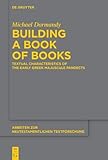Building a Book of Books : Textual Characteristics of the Early Greek Majuscule Pandects / Michael Dormandy.
Material type: TextSeries: Arbeiten zur neutestamentlichen Textforschung ; 54Publisher: Berlin ; Boston : De Gruyter, [2024]Copyright date: 2024Description: 1 online resource (X, 382 p.)Content type:
TextSeries: Arbeiten zur neutestamentlichen Textforschung ; 54Publisher: Berlin ; Boston : De Gruyter, [2024]Copyright date: 2024Description: 1 online resource (X, 382 p.)Content type: - 9783110994575
- 9783110981377
- 9783110981278
- 220.486
- online - DeGruyter
- Issued also in print.
| Item type | Current library | Call number | URL | Status | Notes | Barcode | |
|---|---|---|---|---|---|---|---|
 eBook
eBook
|
Biblioteca "Angelicum" Pont. Univ. S.Tommaso d'Aquino Nuvola online | online - DeGruyter (Browse shelf(Opens below)) | Online access | Not for loan (Accesso limitato) | Accesso per gli utenti autorizzati / Access for authorized users | (dgr)9783110981278 |
Browsing Biblioteca "Angelicum" Pont. Univ. S.Tommaso d'Aquino shelves, Shelving location: Nuvola online Close shelf browser (Hides shelf browser)

|

|

|

|

|

|

|
||
| online - DeGruyter Between Text, Meaning and Legal Languages : Linguistic Approaches to Legal Interpretation / | online - DeGruyter Briefwechsel : Kritische Gesamtausgabe. Band 5. Abteilung 3. Briefe von Friedrich Nietzsche Januar 1887 - Januar 1889 / | online - DeGruyter Kant for Children / | online - DeGruyter Building a Book of Books : Textual Characteristics of the Early Greek Majuscule Pandects / | online - DeGruyter Managing Migration in Italy and the United States / | online - DeGruyter Interactional Humor : Multimodal Design and Negotiation / | online - DeGruyter Œuvres complètes. XIV. Correspondance générale. Correspondance générale 1825–1826 / |
Frontmatter -- Acknowledgements -- Preliminary Notes -- Contents -- Introduction -- 1 Relevance and Methodology of the Project -- 2 Historical Background to the Four Pandects -- 3 Analysis of Variants in Romans -- 4 Analysis of Variants in John -- 5 Analysis of Variants in Revelation -- 6 Analysis of Variants in Sirach -- 7 Analysis of Variants in Judges -- 8 Results and Conclusions -- Bibliography
restricted access online access with authorization star
http://purl.org/coar/access_right/c_16ec
This book analyses how the early Greek whole-Bible manuscripts (pandects) change and preserve the text. Dormandy refutes the method based on singular readings and so investigates all the ways in which each pandect differs from the initial text, both changes introduced by its own scribe and by the scribes of earlier manuscripts. He surveys sample chapters in John, Romans, Revelation, Sirach and Judges (including discussing the “new finds” of Sinaiticus). Dormandy’s observations of Codex Ephraemi challenge accepted transcriptions. Dormandy argues that Sinaiticus and Vaticanus may plausibly have been made in response to commissions by Constantine and Constans. Dormandy concludes that generally, across all the Biblical books considered, the pandects preserve the initial text well. Transcriptional and linguistic variations are more common than harmonisations or changes of content. The more precise profiles of each manuscript vary between Biblical books. The pandects thus create bibliographic unity from textual diversity. This shows their significance in the history of the Christian Bible: they reflect in bibliographic form the hermeneutical move to consider all the books of the Christian Bible as one corpus.
Issued also in print.
Mode of access: Internet via World Wide Web.
In English.
Description based on online resource; title from PDF title page (publisher's Web site, viewed 20. Nov 2024)


